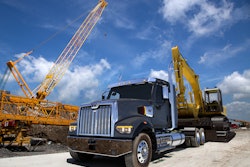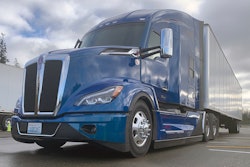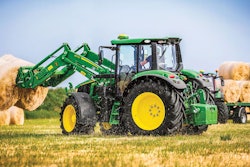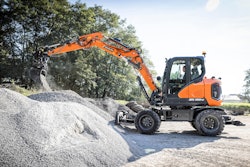Among the contestants in the 2024 Mid-America Trucking Show’s Big Rig Build-Off was a super-semi tractor outfitted with a diesel engine from a Cat D11 dozer.
Dickerson Custom Trucks spent 10.5 weeks building its entrant for the contest, converting “a run-of-the-mill 1996 Peterbilt 379 into a one-of-a-kind showpiece,” writes Matt Cole in our sister publication, Overdrive.
Overdrive shot the video above of DCT owner Dustin Dickerson discussing the conversion of the truck into “Storm Surge.” The truck got the nickname because it will eventually be part of the fleet of Hurricane Specialized in Franklin, Indiana.
Fitting the big Cat 3412 diesel into the custom truck’s body proved no easy feat. They wanted to prevent the hood from looking too long, so they had to figure out a way to insert the engine without having to extend the hood, which was made for a 389 Peterbilt.
“We put a 389 hood on it,” Dickerson tells Matt. “I needed a little extra room to get this 3412 Cat motor in there. I didn't want to stretch the hood. I've seen some trucks that get a little bit long looking with the extended hoods, and I wanted to cram the big engine underneath there.”
They removed all the dozer drives, auxiliary pumps and oil coolers from the engine. They found a bell housing for a Cat 3408 engine for semis and used that to make the stripped-down 3412 fit.
They still needed 4 extra inches of space.
“We took all the hub and everything, the fan that's running electric fans on a custom-built radiator,” he tells Matt. “And when we did that, we were able to push that motor a little bit forward, move the cab back 4 inches to accommodate the 389 hood.
“We were able to get that underneath there without having to stretch the hood skins.”
They customized the intake and exhaust system. It also got a green coat of paint to match the custom truck’s color scheme.
“It's not typical to what you would see in a truck for sure, or even a dozer anymore,” Dickerson says.
 Dickerson had to take off all of the dozer drives, the auxiliary pumps, oil coolers and other parts that weren’t needed for a truck. It has custom headers and a custom air induction system. They used a bell housing that would fit a 3408 Cat engine to give some additional space, then pushed the motor forward a little bit and moved the cab back 4 inches to accommodate the 389 hood.
Dickerson had to take off all of the dozer drives, the auxiliary pumps, oil coolers and other parts that weren’t needed for a truck. It has custom headers and a custom air induction system. They used a bell housing that would fit a 3408 Cat engine to give some additional space, then pushed the motor forward a little bit and moved the cab back 4 inches to accommodate the 389 hood.
Dustin Dickerson: I am Dustin Dickerson. I'm the owner of Dickerson Custom Trucks out of Thorntown, Indiana. We've been in the same building for about 20 years. We started out doing cars and trucks and motorcycles and things and kind of transitioned into semis. Really been catching our stride here in about, I'd say the last five years or so. We've really been stepping up our game. We've been doing semis for about 10 or 11 years, really trying to raise the bar, not only on the whole industry, but ourselves especially. We've tried to always outdo the one we did before, and that's what we were striving to do here.
When we were invited to the 2024 build off, certainly honored to get that invitation. That was something that I felt like was acknowledgement to where we have pushed ourselves to in our career.
We started out with a ‘96, 379 that I actually hauled a little bit of corn with this last fall. So it was very much a work truck. It was a nice truck. It wasn't a piece of junk by any means, but we re-skinned the entire body, every rivet, every panel, roof cap, all of it, everything new. We put the newer 389 skins on it, so it reduced the amount of rivets to really clean that up a lot.
We put a 389 hood on it. I needed a little extra room to get this 3412 Cat motor in there. I didn't want to stretch the hood. I've seen some trucks that get a little bit long looking with the extended hoods, and I wanted to cram the big engine underneath there.
So we got rid of all the pump drives. So the motor came out of a D11 dozer to start with, so it was rather large with all the dozer drives, all the auxiliary pumps and the oil coolers and different things like that. So we had to get rid of all that, but we were able to get a bell housing that would fit like a 3408 that you can get in a semi. So it had the proper bell housing size and bolt pattern and things. So we did that and was able to get it down in there somewhat easy, but we needed that extra four inches. We took all the hub and everything, the fan that's running electric fans on a custom-built radiator, and when we did that, we were able to push that motor a little bit forward, move the cab back four inches to accommodate the 389 hood, and we were able to get that underneath there without having to stretch the hood skins.
It's not typical to what you would see in a truck for sure, or even a dozer anymore. We moved, made headers for it, buddy of mine, Josh Wheland out of Fresno, California, came out that I went to college with and built the headers for us.
We had Brad Moss and Forest Machine valve covers for us and the intake plume. There's really nothing about that intake and exhaust system that's factory. Well, there's not a lot that's factory about any of it to be honest, but especially the air induction system.
The truck starts out black and the color is called Bomb Pop and it's from Paint Huffer, and they do a little stuff to it and then we tweaked it a little bit beyond that just so we'd be sure it'd be the only ones with it. But same with the green. I forget what the green is called offhand, but starts out Kawasaki green and then we have a special pearl that they mix in with some House of Colors stuff. And then again, we tweaked it a bit further than that and put the silver pinstripe around it. So my oldest daughter, Kendall, actually came up with the stripe design. She and I both talked about colors and we kind of settled in on this. I probably influenced that a bit more than what she would like, but it came out awesome.
We built all of the computer operating system on this truck. We didn't have quite enough time to get all the interior done up the way we want it, especially the dash, but it's all touchscreen. So we were able to have a screen built that goes all the way side to side in that truck, and it's basically think of like a 4K display iPad. So all the gauges are displayed virtually. We've wrote all the code, done all the stuff to monitor all of our pressures and temperatures, speed, RPMs, all the air pressures. Anything that you would expect to have with a full gauge package semi, we're going to have displayed on that dash. All of the switches that would typically be a toggle or a rocker or something like that, they're all virtual, so it's just a touch of the screen, turns all that stuff on right down to the ignition.
When we get it all said and done, it's going to be a biometric, so it'll have a thumbprint reader and on the outside of the door there, it'll pop the door open. Then you get inside, thumbprint reader will fire up the computer and put it through its power up signal, power up mode. And we actually hired a graphics artist to have a startup sequence that every time you fire the truck up, it plays just like a lot of your modern vehicles.
So we've really tried to raise the bar on our own abilities, force ourselves to try to evolve and do some things that haven't been done, and I sure think we've pulled some of that off. And like I say, it'll be getting some for sure refinement just ran out of time. 10 and a half weeks went by really fast and it's like, okay, we, I built all that out of foam, so we started stacking six-inch blocks of foam, started off looking like something that Fred Flintstone might've had, and it's starting to look dash like. So I'm pretty proud of it honestly. It's quite messy, grinding all that and shaping all that with a grinder. But it is fun. It's like being back in high school trying to learn, just trying to refine your craft and coming up with a neat idea and then execute that idea.
As we walk back, you'll kind of see what we had to do to the back end to get the truck to sit as low as I needed it to.
Matt Cole: What's the ground clearance on it?
Dustin Dickerson: 17 and three quarter from the bottom of the frame to the ground when it's aired out. So pretty dang low. We designed all the cross members at the shop, welded those all in. Those are all quarter-inch sheet metal. They start life just a five by 10 sheet of quarter inch steel and we laser cut it and the guys bend it and form it and make it into something. And we boxed the frame all in after we got our cross members in there and stuff. I knew from a design aspect, I didn't want to run a belly pan or a deck plate if we were going to go to all the trouble to box the frame in. it's kind of silly, it just gives it a different look, you know what I mean? But we put so much effort into getting that drive shaft on top of the cross members. I just couldn't bring myself to cover it all up.
So we did the no deck plate look, but built all the rear suspension for it. When I was drawing it out on the computer program, on the CAD, it ended up kind of looking, it's a little bit hard to tell with the fenders and things on there now, but it's kind of got an old locomotive look to it where the wheels are hooked together. I thought that was pretty neat. So that kind of solidified like, okay, that's the design. I try to not just go with my first drawing. I try to force myself to come up with a few different ideas.
You might come up with something that's neat when you're kind of doodling around. And when I did this one here and just kind of looked back at the drawing, it was just looked like a train with the big engine in there and stuff. I thought it was kind of neat. So we went with that.
So we worked our butts off at the shop. We built this whole truck in 10 and a half weeks. And none of these ideas, or not all these ideas are my own. I've got a hell of a team at the shop and without them, this truck wouldn't be sitting here.









